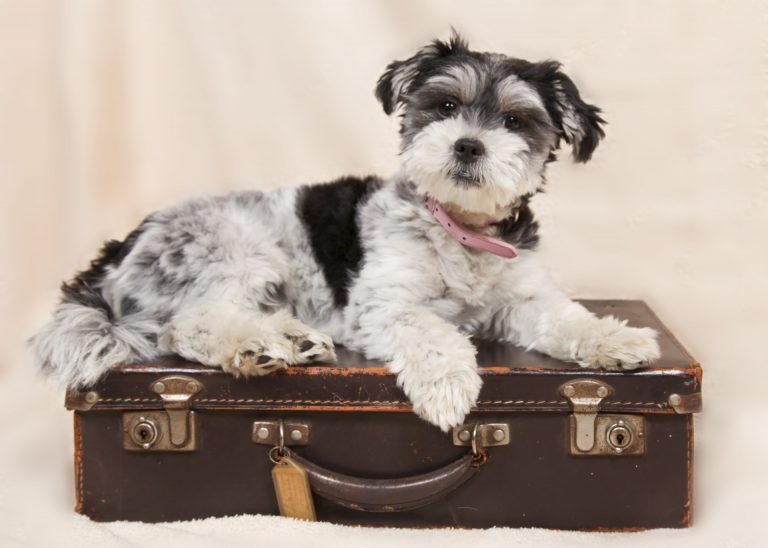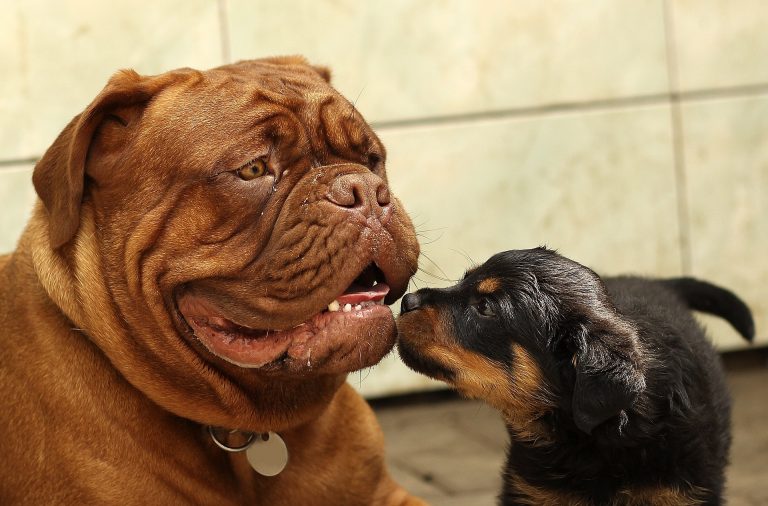If you’re a new puppy parent, you may be wondering how much food to give your pup and how often. It’s important to strike the right balance – give them too little and they won’t get the nutrients they need, but give them too much and you could end up with an overweight dog on your hands. In this blog post, we will discuss the signs that you are overfeeding your puppy, as well as what you can do to mitigate the risks.
If you’re here for the tools you can use to avoid overfeeding your pup, check out this list!
Every puppy has adorable curves, but would you be able to tell if your puppy was overweight?
Obesity is not something we normally think about when we see a puppy, after all, it’s called ‘puppy fat’ for a reason.
But, unfortunately, overfeeding is a well-meaning reality with a lot of pet owners. Being able to tell the difference between puppy rolls and an overweight puppy can be the difference between a healthy, active adult dog and a dog with medical issues.
How do you know if you are overfeeding your puppy? Three easy ways to tell if you’re overfeeding your puppy
Heavier than average according to breed and sex
If your puppy is heavier than average for their breed and sex, then you are probably overfeeding them. On the other hand, if they are thinner than average, then they may not be getting enough food. Of course, every puppy is different, so it’s important to pay attention to their energy levels and overall health. If you’re ever in doubt, it’s best to consult with your veterinarian.
Take note of your puppy’s bowel movements
Most people are unaware that you can tell if you are overfeeding your puppy by the quality of their bowel movements. A normal, healthy stool followed by soft stools in the evening is a good indication that you are feeding them too much. It is important to monitor their stool quality closely, as overfeeding can lead to health problems such as obesity and digestive issues. By paying attention to their diet, you can ensure that your puppy stays healthy and happy.
Check out your puppy’s body condition score
A healthy puppy should have a slight hourglass shape, with the ribs being visible but not protruding. If the ribs are not visible, this may be an indication that the puppy is overweight and could be at risk for health problems later in life. On the other hand, if the ribs are visible but the waist is not defined, this could be an indication that the puppy is underweight and may need more food. By keeping an eye on the body condition of a puppy, owners can ensure that they are getting the proper nutrition.
Click HERE for a body condition score chart to help you out.
Ref: A five out of nine is a perfect body condition score where the dog or the cat has sort of an hourglass figure and you can see some of the ribs.
What happens if you overfeed a puppy?
Overfeeding a puppy can have a number of consequences. Firstly, it can lead to rapid weight gain, which can put a strain on the puppy’s developing joints and bones. It can also lead to the puppy becoming obese, which can cause a range of health problems in later life. Finally, overfeeding can result in the puppy developing a taste for rich food, which may lead to them becoming fussy eaters.
In summary, overfeeding a puppy can have serious implications for its health and well-being. It is therefore important to be careful when choosing their food and to only give them as much as they need. Here’s a list of common health problems in puppies from overfeeding.
Weight Gain
Overfeeding a puppy can lead to weight gain, which can be harmful to their health. Puppies are growing and need extra calories to fuel their growth, but too many calories can lead to weight gain. Overweight puppies are also more likely to become obese adults, which can lead to a number of health problems including joint problems, diabetes, and heart disease. It’s important to feed puppies the right amount of food, so they grow into healthy, happy adult dogs.
Skeletal & Joint Problems
Overfeeding a puppy can lead to rapid bone growth, which can cause long-term development issues. When puppies are overfed, they often gain weight too quickly. This excess weight puts unnecessary stress on their joints and bones, which can stunt their growth or cause joint problems later in life.
Hip Dysplasia
Can overfeeding a puppy cause hip dysplasia? This is a question that has been debated among dog breeders for years. Some believe that overfeeding can lead to joint problems, including hip dysplasia, while others contend that the real cause of this condition is genetics. The truth is, however, that there is no definitive answer. Some puppies who are overfed do develop hip dysplasia, while others who are fed a normal diet do not. The best way to prevent this condition is to feed your puppy a balanced diet and make sure they get plenty of exercise.
Bowel Issues and abdominal discomfort
Overfeeding a puppy can also cause problems with its digestive system, leading to episodes of diarrhea or vomiting. In some cases, this can lead to dehydration if not treated promptly.
Flatulence or Dog Bloat
Puppies are notoriously gassy creatures. It’s not uncommon for them to pass gas several times a day, sometimes even more. But while a little flatulence is normal for puppies, too much can be a sign that they’re being overfed. When puppies eat more than their bodies can digest, the excess food ferments in their intestines, causing gas. This can lead to uncomfortable bloating and discomfort for the pup, as well as some very smelly farting! If your puppy seems to be farting more than usual, try cutting back on their food a bit and see if it makes a difference.
Itchiness
Overfeeding a puppy can have a number of adverse effects on its health, one of which is itchiness. When a puppy eats more food than they need, its body has to work harder to process the excess nutrients. This can put a strain on their organs and can cause problems like dry skin and itching.
Tear Staining
Tear staining is a common problem for many dog owners, especially those with smaller breeds. The condition is caused by a build-up of tears in the tear ducts, which can be triggered by a number of factors, including overfeeding. In addition, overfeeding can also cause tears to build up in the tear ducts, leading to tear staining.
Lethargy
One of the most common problems that veterinarians see in puppies is overfeeding. Puppies are born with high metabolisms and require more calories per pound of body weight than an adult dog. However, many well-meaning pet owners mistakenly believe that feeding their puppy more food will help them to grow faster and reach their full size sooner. As a result, overfed puppies often suffer from lethargy, as their bodies are unable to properly process all of the calories they are consuming.
Shorter Lifespan
It’s no secret that puppies are adorable. With their big eyes and wagging tails, it’s hard to resist giving them a little extra food. However, overfeeding a puppy can lead to a number of health problems, including obesity and joint problems. In fact, studies have shown that puppies who are overweight are more likely to have shorter lifespans than those who are of normal weight. So if you’re wondering how you can help your puppy live a long and healthy life, one of the best things you can do is make sure they’re not overeating. By monitoring their food intake and making sure they get plenty of exercise, you can help them stay at a healthy weight and avoid many of the health problems associated with being overweight.
What do I do if my puppy overeats?
You’ve checked out your puppy’s body condition score, you’ve inspected the poop, and you’ve been charting their growth – your puppy is overweight. Now what?
Don’t panic, it’s not too late to change your puppy’s fate! Follow these guides to get your puppy back on track and you’ll have a happy and healthy puppy in no time again.
Puppies develop rapidly in the first year of life, including their vital organs, muscles, and bones. Accidentally overfeeding your puppy can cause abnormal bone growth. For example, large-breed dogs being fed higher amounts of calcium has been linked to painful skeletal issues later in life.
Review food portions and feeding schedule
A feeding schedule can make sure your puppy is being given the correct amount of nutrients.
When you go by the proper guidelines and keep to a daily routine, adding up the calories will be a lot less work.
By feeding your puppy the same amount at the same time each day, you will be able to clearly measure your puppy’s food intake.
For an example of a proper feeding schedule, read our article on ‘How to Create the Perfect Puppy Feeding Schedule.’
Keep those yummy treats in check
Maybe you’re not overfeeding your puppy at mealtime, but did you remember to factor in their treats? Lots of dog treats are full of unnecessary fats and sugars. Remember treats should be given sparingly and only be used for training and rewarding desired good behaviors.
Check your pet store for healthy alternatives, or give your puppy appropriate fresh fruits and veggies for snacks!
Up your puppy’s play and exercise
An extra twenty minutes playing catch, walking around the block one more time, or bringing your pup for a short swim can reduce that chubby tummy.
See your veterinarian
A simple trip to the vet could save your puppy some major aches and pains in their adult life. So you can develop a good weight management program.
Your puppy deserves to grow up with a healthy ideal weight, and you’re the only one who can make the changes they need so checking if you’re overfeeding your puppy and make changes today!
Your puppy deserves to grow up with a healthy ideal weight, and you’re the only one who can make the changes they need so checking if you’re overfeeding your puppy and make changes today!
FREQUENTLY ASKED QUESTIONS
Can overfeeding a puppy cause diarrhea?
Yes. Overfeeding a puppy can cause diarrhea for several reasons. First, the puppy’s digestive system is not yet fully developed, and too much food can overwhelm it. Second, puppies are more prone to developing food allergies than adults, and an overabundance of food can trigger an allergic reaction. Finally, puppies typically have a high metabolism, and they may burn off more calories than they consume if they are overfed. This can lead to weight loss and diarrhea. Therefore, it is important to feed puppies small meals several times a day rather than one large meal. This will help them to digest their food properly and avoid developing diarrhea.
Can overfeeding puppy cause blood in stool?
Overfeeding a puppy can cause blood in stool for a number of reasons. First, when a puppy is overfed, they can develop sharp points on their stools that can cut or tear the anus or rectum, leading to bleeding. Second, an overfed puppy’s stomach may become distended, putting pressure on the veins in the stomach and causing them to bleed. Finally, when a puppy eats too much food, they may not be able to properly digest it all, leading to bloody diarrhea. If you see blood in your puppy’s stool, it is important to take them to the vet right away to rule out any serious medical conditions. In the meantime, cut back on their food intake and try feeding them smaller meals more often.
Can overfeeding a puppy cause loose stools?
The answer is yes. When puppies eat too much, their stomachs can’t digest all the food properly and some of it ends up passing through their system in the form of loose stools. In addition to being messy, this can also lead to dehydration and malnutrition. So if you’re worried that your puppy is eating too much, look out for signs of loose stools and make sure to cut back on their food intake.
Can overfeeding a puppy cause vomiting?
While most people know that it’s important to feed their puppy a nutritious diet, some may not realize the potential dangers of overfeeding. One common problem that can occur is vomiting. This is usually caused by eating too much food too quickly, which can be a particular problem for puppies who are still learning to control their food intake.
Can overfeeding a puppy cause constipation?
It is a common myth that overfeeding a puppy can cause constipation. However, this is not the case. The reality is that constipation is more likely to be caused by a lack of fiber in the diet or by dehydration. Puppies are also more prone to constipation if they are not getting enough exercise. In most cases, constipation can be easily treated by adding a reasonable amount of healthy fiber to the diet or increasing the amount of water that the puppy drinks. However, if constipation persists, it is important to consult with a veterinarian to rule out any underlying medical conditions.
Can overfeeding a puppy make them sick?
It’s tempting to want to spoil a new puppy with lots of treats, but it’s important to be careful not to overfeed them. Too much food can lead to health problems, including indigestion, obesity, and even pancreatitis. Signs that a puppy is being overfed include vomiting, diarrhea, and a distended abdomen.
Things To Help Avoid Overfeeding Your Puppy

























